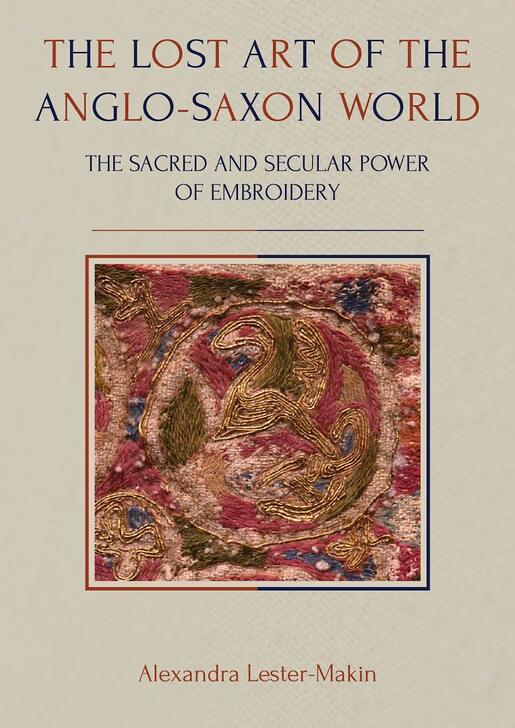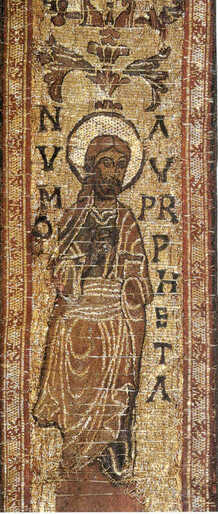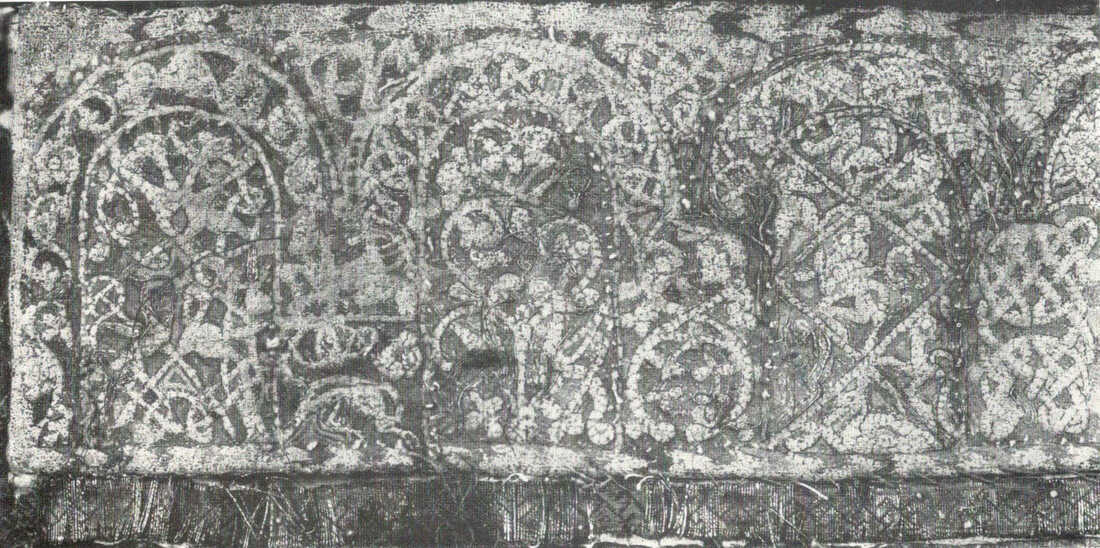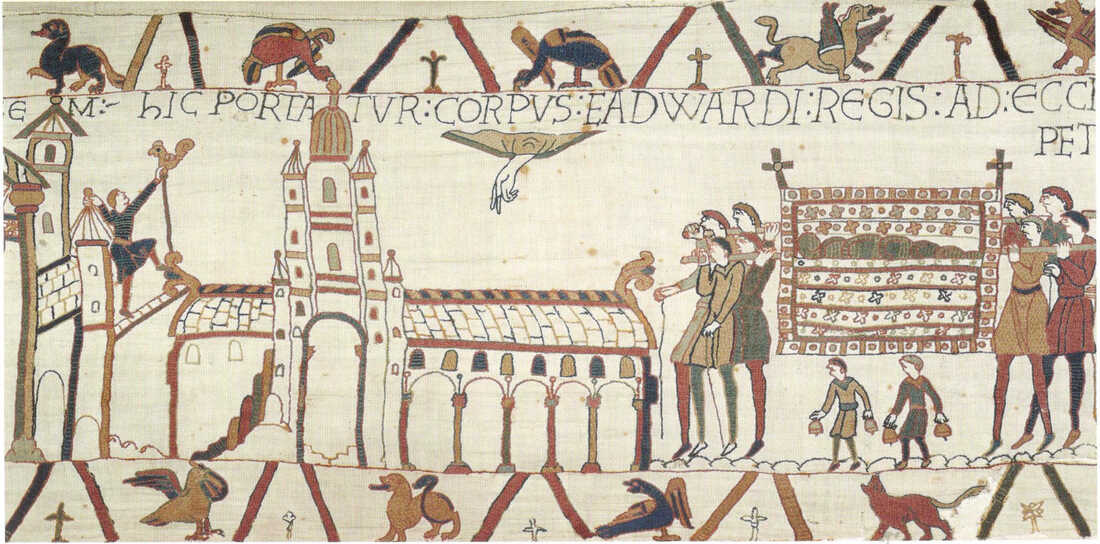Book review: The lost art of the Anglo-Saxon world. The sacred and secular power of embroidery.15/6/2020 For most of you, it will come as no surprise: I am a book lover! And many of you regularly mention books on embroidery to me which would be worthy additions to my library. The lost art of the Anglo-Saxon world by Alexandra Lester-Makin is one of these latest additions. It isn't a project book, but a properly published PhD-thesis. Don't let that scare you. As Alexandra is both an archaeologist and a Royal School of Needlework apprentice this makes for an interesting read. Research into other art forms, such as painting and sculpture, never goes out of fashion. Researching embroidery and its makers seems to go through cycles. At the moment we clearly experience a renewed interest in this often under-appreciated art form. The book is divided up in six chapters and comes with an elaborate catalogue. After a chapter on the introduction of Anglo-Saxon embroidery comes a chapter on the data and its difficulties. As you probably already knew, there isn't much embroidery left from the Early Medieval period (c. AD 410-1066 for the British isles). For the more than 600 years under scrutiny, there are only 41 embroideries to work with. Of these, only three are more or less complete: the Cuthbert embroideries from Durham, the Maaseik embroideries in Belgium and the Bayeux tapestry. All other embroideries are fragments. In some cases, only the holes have survived and not the embroidery thread. In other cases, there is no original material left as we deal with an imprint on a metal object (mineralisation) or complete carbonisation due to fire. Oh, and then there are the fragments that are unavailable for inspection as they are either too fragile, mounted in such a way that they are inaccessible or they have simply vanished... Precisely dating them is often a problem too. As a fellow archaeologist who worked with animal bones instead of embroideries, I was rather sceptical when I realised the data set the research is based on is so small and wrought with so many difficulties. Would I have written my PhD-thesis on 41 samples of animal bone of which were three more or less complete skeletons, the rest fragments: either burnt, inaccessible or lost? Often only broadly dated. And then come up with a coherent story on husbandry, hunting, fishing, trade and bone working over a period of more than 600 years in all of Germany? Nope. Instead, I had thousands of bones, in very good condition, many well-dated and almost all available for my inspection. Still, I wasn't able to do more than draw tentative conclusions and hypothesise on animal keeping and the use of animal products in medieval Emden. Does this mean that I think Alexandra did a bad job? No, not at all! But comparing her archaeological data set to mine hopefully shows you how little it is we really know. And that Alexandra had to come up with a theoretical archaeological framework to be able to extract as much information from each data set entry as she could. That she did rather brilliantly! In chapter 3, Alexandra shows us in great detail how she extracts as much information from an embroidery fragment as she possibly can by writing its object biography. In this object biography, she includes detailed technical analysis, careful study of related attributes and context, and related documentary evidence. And that for the whole life-span of the fragment up until the present day. Being both an archaeologist and a professional embroiderer, Alexandra is very well equipped to undertake this kind of research. With this theoretical research framework in place, she then analyses all the embroideries at her disposal. The results form the basis of chapter 4 (Embroidery in Anglo-Saxon society) and chapter 5 (Early medieval embroidery production in the British Isles). And I am quite impressed with the ideas she comes up with. For instance, although there are not many written sources on the training of professional embroiderers in the early medieval period, careful analysis of stitch length and execution leads her to conclude that the embroiderers must have had extensive training to be able to achieve the level of perfection they did. Or giving us archaeologist something to think about when we excavate a dwelling site. Could a certain building have housed an embroiderer? Is there enough natural light coming in? Can it be kept clean? Not necessarily lines of thought an archaeologist or an art historian would have come up with. Other conclusions she draws regarding the use of certain types of stitches going in and out of fashion, I find harder to justify with the patchy nature of the data set. Although they seem to correlate with the pagan versus the Christian nature of society, we should not forget that this might be pure coincidence and might well change when further embroidery fragments are unearthed. That said: I like the idea of looped stitch being viewed as the mythological serpent that both protected the pagan wearer and the seam from coming apart. Personally, I have learned a lot from reading this book. Too often I am reluctant to publish my own embroidery research as I feel that my database is too patchy. Alexandra's research approach has given me an opening on how to extract more information from my database. And she has given me the guts to put my findings out there despite the patchy nature of the database. After all: if you don't put your hypotheses out there for contesting, you are not helping to advance the research of historical embroidery. Alexandra did and does.
Literature Browne, C., G. Davies & M.A. Michael (eds.) (2016) English medieval embroidery: Opus Anglicanum. London: Victoria & Albert Museum. Grimm, J.M. (2010) Animal keeping and the use of animal products in medieval Emden (Lower Saxony, Germany), self-published. Lester-Makin, A. (2019) The lost art of the Anglo-Saxon world: the sacred and secular power of embroidery. Oxford: Oxbow Books. Schuette, M. & S. Müller-Christensen (1963) Das Stickereiwerk. Tübingen: Wasmuth.
1 Comment
That's a good point - there's so little surviving material that we have to a) have a good framework for our interpretations b) be willing to guess and c) be willing to be proven wrong!
Reply
Your comment will be posted after it is approved.
Leave a Reply. |
Want to keep up with my embroidery adventures? Sign up for my weekly Newsletter to get notified of new blogs, courses and workshops!
Liked my blog? Please consider making a donation or becoming a Patron so that I can keep up the good work and my blog ad-free!
Categories
All
Archives
July 2024
|
Contact: info(at)jessicagrimm.com
Copyright Dr Jessica M. Grimm - Mandlweg 3, 82488 Ettal, Deutschland - +49(0)8822 2782219 (Monday, Tuesday, Friday & Saturday 9.00-17.00 CET)
Impressum - Legal Notice - Datenschutzerklärung - Privacy Policy - Webshop ABG - Widerrufsrecht - Disclaimer
Copyright Dr Jessica M. Grimm - Mandlweg 3, 82488 Ettal, Deutschland - +49(0)8822 2782219 (Monday, Tuesday, Friday & Saturday 9.00-17.00 CET)
Impressum - Legal Notice - Datenschutzerklärung - Privacy Policy - Webshop ABG - Widerrufsrecht - Disclaimer










 RSS Feed
RSS Feed